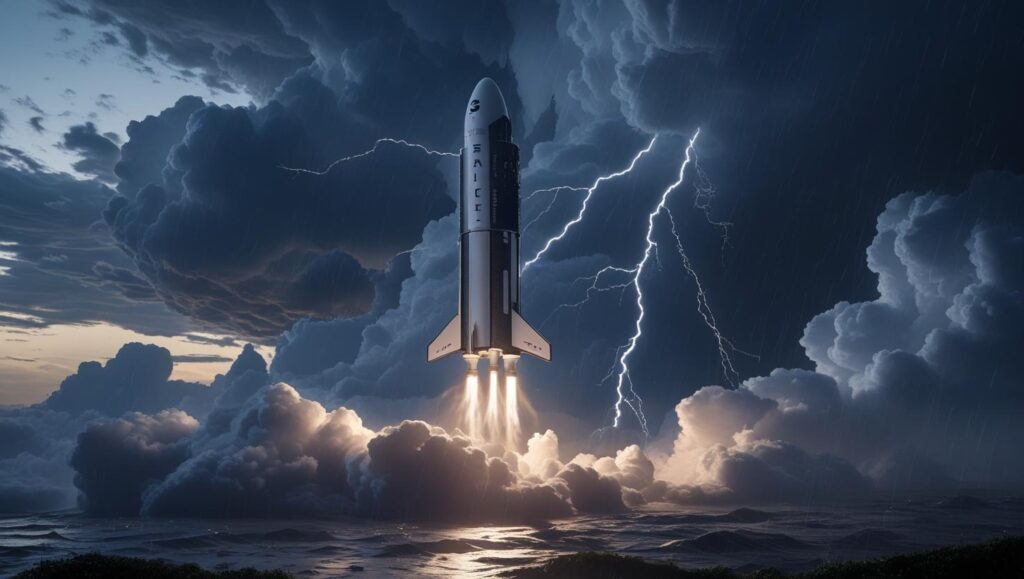🚀 Stormy Weather Derails SpaceX Starship Test Flight | Latest Update
SpaceX’s Starship test flight was delayed due to stormy weather in Texas. Find out why the launch was scrubbed, its impact on NASA’s Artemis, and what’s next.

Introduction
Space exploration often faces challenges beyond engineering and science — nature itself can be the biggest obstacle. This was evident when stormy weather forced SpaceX to delay its much-anticipated Starship test flight, leaving space enthusiasts, engineers, and investors eagerly waiting.
SpaceX, led by Elon Musk, has ambitious goals with Starship — from building a fully reusable rocket system to taking humans to the Moon, Mars, and beyond. But even the most advanced spacecraft remains vulnerable to Earth’s atmosphere. In this article, we’ll explore what went wrong, why weather matters so much in rocket launches, how this impacts SpaceX’s plans, and what comes next for Starship.
What is Starship and Why is it Important?
SpaceX’s Starship is the most powerful rocket ever built, designed to carry humans and cargo to deep space.
- Fully Reusable Design: Unlike traditional rockets, Starship aims for full reusability, drastically reducing launch costs.
- Heavy Payload Capacity: Capable of carrying more than 150 metric tons into orbit.
- Mars & Moon Missions: Central to NASA’s Artemis program for lunar landings and Musk’s vision of a Mars colony.
- Satellite Deployment: Could revolutionize space-based internet, defense, and communications.
Starship is not just another rocket — it’s a paradigm shift in space technology. That’s why every test flight draws global attention.
The Planned Test Flight
The delayed test was expected to be one of the most critical Starship launches yet, involving:
- Super Heavy Booster: The massive first stage designed to return and land after separation.
- Orbital Trajectory: A near-orbital flight to test endurance and atmospheric reentry.
- Heat Shield Trials: Checking the ability of Starship’s tiles to withstand extreme temperatures.
- Landing Precision: Aimed at demonstrating safe splashdown or controlled landing.
This mission was a milestone in proving Starship’s reliability for human spaceflight.
Why Stormy Weather Stopped the Launch
Rocket launches depend on strict weather criteria. SpaceX’s team monitors wind, lightning, rain, and cloud conditions.
Key Weather Factors Affecting Launches:
- High Winds: Can destabilize the rocket during liftoff.
- Lightning Risk: Rockets can trigger lightning strikes, endangering onboard systems.
- Cloud Cover: Thick clouds affect visibility and can impact tracking systems.
- Rainstorms: Moisture damages sensitive rocket components.
On the scheduled day, stormy conditions near Boca Chica, Texas, created unsafe circumstances. The combination of strong winds, dense clouds, and lightning potential forced mission controllers to scrub the launch.
The Domino Effect of Delays
Postponing a rocket test is not just about waiting for better weather — it has broader consequences.
- Technical Adjustments: Every delay requires recalibration of systems, fueling, and safety checks.
- Scheduling Backlog: Launch sites operate on tight schedules, meaning one delay affects future launches.
- Financial Costs: Each delay adds to operational costs, although reusability reduces losses.
- Global Attention: SpaceX faces pressure as investors and NASA closely track progress.
Elon Musk himself has often said: “Space is hard. Nature is harder.”
SpaceX’s Safety-First Approach
Although fans get frustrated with delays, SpaceX prioritizes safety and precision. Launching in unsafe weather could risk:
- Loss of the rocket.
- Damage to ground infrastructure.
- Most critically, danger to future crewed missions.
SpaceX has previously delayed launches for weeks — but history shows it’s better to wait for the right window than risk catastrophic failure.
Reactions from Space Enthusiasts
The scrubbed launch created a storm of reactions online:
- Space Fans: Expressed disappointment but supported the safety-first decision.
- Critics: Pointed to repeated delays as signs of SpaceX overpromising timelines.
- Investors: Watching closely since Starship’s success is linked to SpaceX’s $150+ billion valuation.
- NASA & Artemis Program: Still optimistic, but delays may slightly shift schedules for lunar missions.
Historical Context: Weather & Rocket Launches
Weather has derailed many iconic missions in history:
- Apollo 12 (1969): Rocket struck by lightning seconds after launch.
- Space Shuttle Era: Numerous scrubs due to Florida storms.
- Falcon 9 Launches: SpaceX has previously delayed multiple Starlink deployments for wind and rain.
This shows that weather remains a timeless challenge in spaceflight, no matter how advanced rockets become.
spacex starship test flightspacex starship test flightspacex starship test flightspacex starship test flightspacex starship test flightspacex starship test flightspacex starship test flightspacex starship test flightspacex starship test flightspacex starship test flight
What’s Next for Starship?
SpaceX is now waiting for a clear launch window. Updates suggest:
- A 24 to 72-hour window after weather clears.
- Backup launch dates already planned.
- Additional checks on heat tiles and engines after extended waiting time.
- NASA’s Artemis III timeline still sees Starship as the lander, but every test counts.
Elon Musk hinted on X (Twitter) that the next window could be “very soon, if weather plays nice.”
Outbound Trusted References
FAQs (Schema-Friendly)
Q1: Why was the SpaceX Starship test flight delayed?
Because of stormy weather conditions including strong winds, lightning risk, and cloud cover, which made launch unsafe.
Q2: Where was the launch supposed to happen?
At SpaceX’s Starbase facility in Boca Chica, Texas.
Q3: Does this delay affect NASA’s Artemis program?
Not significantly yet, but repeated delays could impact NASA’s 2026+ lunar mission schedules.
Q4: How many times has Starship been delayed?
Multiple times since 2023, due to technical challenges, regulatory approvals, and weather.
Q5: When will the next launch happen?
SpaceX is targeting the next clear weather window within days, but official confirmation will depend on safety reviews.
Conclusion
The stormy weather derailment of SpaceX’s Starship test flight reminds us that while technology has advanced, nature still has the final say. Every scrubbed launch is a learning step toward safer, more reliable missions.
Starship represents humanity’s best hope for interplanetary travel, and even though setbacks are frustrating, they underline SpaceX’s commitment to precision and safety.
As Musk often emphasizes, “Making life multiplanetary will take time, patience, and persistence.” This delay is just one more step in a journey that could redefine the future of space exploration.

